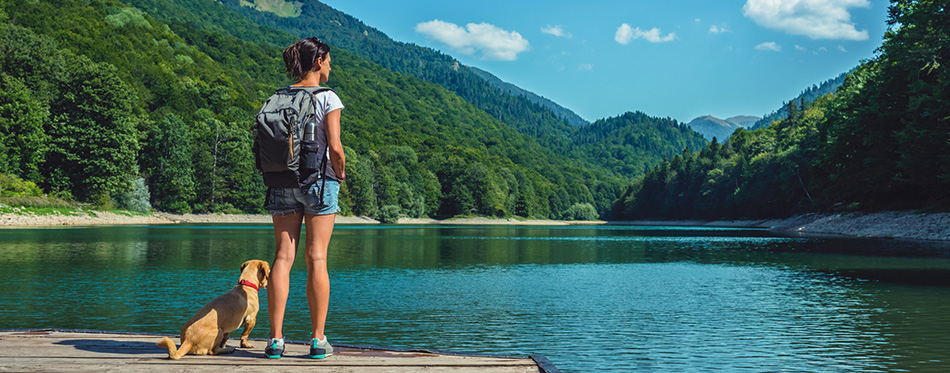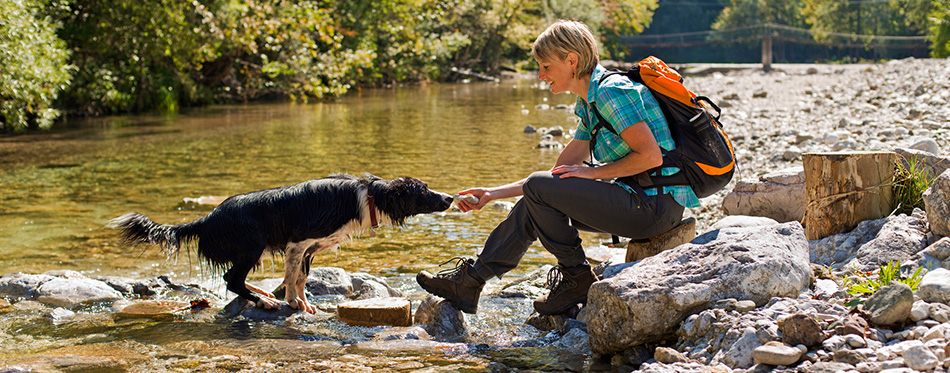Many dogs love the outdoors as much as they love their favorite treats. Some can get excited by the feel of their owners putting a daypack over their backs. And if you’re the outdoor junkie type of pet parent, then you’d love to take Fido for a hike, too. Dogs make excellent hiking partners. You won’t hear them complain. All you’ll see from their faces is the genuine appreciation for letting them tag along. However, the hiking trails can also come with certain risks. It is your job to make sure that the memories you’ll share with your hiking dogs are positive ones. Here are 10 essential tips you can observe to make sure you get the best hiking experience with your canine friend.

Make Sure Your Dog Gets a Clean Bill of Health
There are canine breeds that are great outdoor dogs. This does not mean, however, that all dogs of a particular breed are already fit to hike. Each dog can have a medical condition that can hamper its ability to hike long trails. For instance, having hip dysplasia puts stress on the joints of its hind legs. When it is severe, it can lead to arthritis which can affect the dog’s ability to move with efficiency. If you are looking for more options, check out our guide on dog joint supplements.
Obese dogs may also find it challenging to walk longer distances. The same is true for dogs that may have respiratory problems or heart issues. You may want to bring Fido to your vet to have a general checkup a week before you hit the trail. It is also wise to get flea and tick treatments as these pests thrive in the great outdoors. You may also want to have your dog vaccinated for heartworm and other diseases. For more options, check out our detailed review of heartworm medicine for dogs.
Some pet parents take their dog on a pre-hike training. This often involves several trips from the home to the dog park several times every day. Some may take longer walks than usual. This will help build the dog’s stamina. It is also important to train your dog to behave itself when in the company of other dogs or other people. You’ll be meeting these on the trail. Make sure your dog doesn’t get too excited at the sight of other people and other dogs.
You may also like our article on Flea Collars for Dogs.
Choose a Dog-friendly Hiking Trail
Not all hiking trails allow dogs or any other pet. Take the Appalachian Trail, for example. This 2,000-mile trail has sections where dogs cannot join their owners in the hike. It is for this reason that you need to choose a dog-friendly hiking trail. You can visit the official website of the National Park Service for a list of hiking trails and state and national parks that allow dogs.
It is also important to learn the different rules in a particular dog-friendly trail. For instance, there are some parks and trails that allow dogs only if they are on their leash. There are also those that allow dogs to roam free. It is best to keep your dog on a leash, though the trail says it’s okay for them not to have it on. This is for your dog’s own protection. There can be wildlife lurking in a bush that your dog may run after all of a sudden.
Make sure to choose a trail that is easy on your dog’s paws. Sharp rocks can hurt its paws. It’s best to hike on dirt paths. You also have to consider the temperature. If you hike on warm days, make sure the hiking trail has plenty of shade to offer. Access to water is also crucial. Keep these things in mind when choosing a dog-friendly hiking trail.
Respect Other Hikers, Nature-Seekers, and the Eco-System
This is one reason why you have to hike with your dog on a leash. Unless Fido can contain its excitement at the sight of everything new, it’s best to have control of its movements. This is where a good-quality leash can come in. You should understand that this is your dog’s first time in this environment. It will be quite challenging for it to contain its curiosity and excitement.
Other hikers may not be dog-lovers like you. Some have a morbid fear of dogs because of a prior experience. Some may be friendly towards dogs. You will never know what kind of hiker you will meet on the trail. You will also not know if your dog will consider this hiker a friend or a threat.
It is also important to respect the environment. Don’t let your dog leave its feces anywhere on the trail. As such, it is imperative that you bring lots of dog poop bags. You may also want to bring an extra container for the poop bags.
Related Post: Dog Cooling Vest
Be Mindful of Local Wildlife
During the selection of a dog-friendly hiking trail, you should already learn about the local wildlife in the area. This will help you prepare the moment you set foot on the trail. There are some wildlife that do not pose a threat to you and your dog. However, there are those that you need to be wary about. There are also those that seem harmless, but can pack a mean punch.
Coyotes are cunning and are known to have an eye for smaller dogs. Deer and elk may not be aggressive, but can kick your dog if threatened. These wild animals have powerful hind legs that can seriously injure your dog. Rattlesnakes, while they like to stay hidden, can strike if provoked. It is important to pay attention to the natural habitat of these animals so you can steer clear of these.
Bears and mountain lions are always a threat not only to your pet, but to you as well. Porcupines can impale your dog with their sharp quills. Skunks can spray a nasty fluid into your dog’s eyes and make seeing challenging.

Get Your Dog Its Own Backpack
It is best to get your dog its own backpack so you can lighten up some of your load. Your pet can carry its own things like dog food, dog treats, and toys.
When choosing the right dog backpack, it is crucial to consider the weight of your dog. In general, the gross weight of the dog backpack should not exceed 15% of the dog’s bodyweight. As such, if Fido weighs 20 lbs, it can carry a maximum of 3 lbs. This includes the weight of the dog backpack. Healthier, working-type breeds can accommodate up to 25% their weight.
Make sure to choose a backpack that comes with a grab handle. This is a handy feature when hiking in trails with varied elevations. You can grab the handle and assist your dog in climbing up a rock, for instance. It can also be a more secure way to control your dog should it become agitated.
It’s also wise to choose a backpack that comes with reflective features. This can help improve its visibility in dark or low-light conditions. Getting a backpack with bright color can also help improve its visibility on the trail.
Get Your Dog the Right Gear
The outdoors can be unforgiving to your pet. It may be warm and sunny one moment, rainy and windy the next. As such, you should never forget getting the right gear and getup for your pet.
One of the most important gears you can have for your pet is dog boots. Understand, however, that dogs don’t like wearing boots as it doesn’t feel natural. You may want to train your dog first to learn to love wearing its paw wear. Once your dog can walk with confidence using the dog boots, then you can go on a hike.
You may also want to invest in an overnight clothing for your pet. If you’re only hiking for a day, then this is not necessary. But if you’re going to spend the night on the trail, then a dog sleeping bag is a must. You can also consider getting a breathable rain shell for your dog should it start to drizzle.
Take a look at our review of dog umbrellas.
Bring a Canine First Aid Kit
Accidents happen no matter how prepared you think you are. It is for this reason that a basic canine first aid kit be an important part of your dog’s hiking gear.
The first aid kit should include gauze pads, tweezers, scissors, and bandages. You should also have a pet-appropriate disinfectant. Getting one of those paw protection cream products can also help soothe your dog’s paws after a long day of hiking. Having the contact number of a vet nearest to the hiking trail is also important. At least, you will know who to call should an emergency arise. If you have a dog that is prone to overheating, you may also want to include a dog cooling pad in its canine first aid kit. This will help prevent the complications of overheating.
You may not use this first aid kit during your hiking but it sure is a lot better than having nothing when an accident occurs.
Check out our articles on Paw Protection Waxes and Dog Paw Cleaner.
Pack Your Dog’s Food, Treats, Toys, and Water
Dehydration is a real threat whenever you and your dog go for a hike. The searing heat can increase the chances of heat exhaustion. And if you have a dog that has a short snout, then the danger of overheating becomes all the more real.
It is important to bring your dog’s own water with you. This is despite the fact that there may be bodies of water on the trail. You can never be too safe when it comes to your pet’s hydration needs. Carrying a dog water bottle should keep your dog well-hydrated and prevent overheating. It also helps protect your dog from water-borne diseases it may get from drinking unsafe water on the trail.
It is also wise to bring your dog’s food, treat, and toys. Its food should give your dog the energy to continue with the hike. The dog treats are perfect for keeping Fido interested in the hike or during playtime on breaks. The toys will have a similar effect and make the hike a more pleasant experience for your pet.

Plan for Scheduled and Frequent Breaks
Before you head to the hiking trail, it is best to visualize the points or areas where you need to take a break. Plot on your map way points where you and your pet can take a breather. Depending on the dog breed, taking every 30 to 45 minutes of hiking is a must.
If you navigated difficult or hot terrain, you may want to have more frequent breaks. Take your cue from your pet. If you see it panting faster than usual, that’s often a sign that you need to take a breather. Don’t push it. Working dogs can still benefit from a much-needed break from the hike.
You can have scheduled breaks or take your cue from the dog. You should have an understanding of the impact of the activity and the environment on your dog’s health.
Check Fido Before You Head Home
Before you head back home, it is wise to check your pet for any sign of injuries. Pay attention to its paws as these take the brunt of the hike. Look for cuts or other signs of tissue injury. If you see any, make sure to treat these immediately with your canine first aid.
You may also want to check its coat for ticks and/or fleas. You don’t want to bring these pests into your car and back to your house. This is where your tweezers can be handy. Know how to remove the tick from your pet’s body the correct way.
Look at the areas where the body harness may rub against. These may turn reddish, suggesting skin irritation. You can apply a vet-prescribed anti-inflammatory ointment before you head back home.
Hiking with your dog is fun. By observing these 10 essential tips, you can guarantee a more pleasant and safer hiking experience for you and your hound.
Sources:
- Hiking With Your Dog – PetMD
- How to Hike with Your Dog – HowStuffWorks

